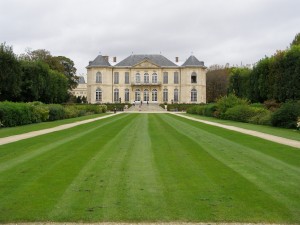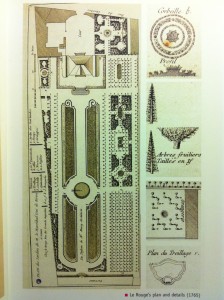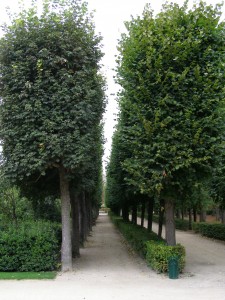 Auguste Rodin’s 172nd birthday is as good a day as any to zoom in on his garden in Paris. Although his garden is not entirely accurate, because the garden we see surrounding Musée Rodin today was only laid out in the first decade after he died in 1917.
Auguste Rodin’s 172nd birthday is as good a day as any to zoom in on his garden in Paris. Although his garden is not entirely accurate, because the garden we see surrounding Musée Rodin today was only laid out in the first decade after he died in 1917.
When Rodin came there and rented what was then known as Hôtel Biron, the garden was fully overgrown, with just enough room to walk on the lawns. 1V. Brocvielle, Rodin Museum – Guide to the Garden, Éditions de Musée Rodin, Paris 2006.
 The 1926 setup of the restored garden is not very different from what we see on 18th century designs. Almost a century ago, harking back to that older style wasn’t strange at all. In this case the parterres with intricate patterns are replaced by borders full of flowering shrubs and winding paths (the Jardin d’Orphee and Jardin des sources). A lawn connecting the house with the pond at two-thirds of the garden forms the centerpiece in combination with those two gardens.
The 1926 setup of the restored garden is not very different from what we see on 18th century designs. Almost a century ago, harking back to that older style wasn’t strange at all. In this case the parterres with intricate patterns are replaced by borders full of flowering shrubs and winding paths (the Jardin d’Orphee and Jardin des sources). A lawn connecting the house with the pond at two-thirds of the garden forms the centerpiece in combination with those two gardens.
This central part is boxed in by clipped trees, forming a screen and lining the paths running towards the end of the garden. In most cases these would be lime trees, and the rows on the outside are. But the row of shaven trees that is best visible from the house/museum building, consists of maple trees.
 The photo to the left shows the maple trees on the left side (where the open central area of the garden is) and the lime trees on the right (where several paths run towards the back of the garden, all lined with lime).
The photo to the left shows the maple trees on the left side (where the open central area of the garden is) and the lime trees on the right (where several paths run towards the back of the garden, all lined with lime).
So in their quest to revive traditional garden styles, known from the drawings of Le Rouge and his predecessor Blondel, the designers of the garden at Musée Rodin used maples in stead of lime trees in one of the most important parts of the garden. A small reminder that this garden was created after the big surge of the landscape style swept over Europe. The style in which fully grown and mature maple trees played such an important role.
Footnotes
| ↑1 | V. Brocvielle, Rodin Museum – Guide to the Garden, Éditions de Musée Rodin, Paris 2006. |
|---|



Hello, I have a question for you regarding the lime trees. What is their scientific name? I ask because in a couple of books I have read on 18-19C English gardens they mention lime trees but do they truly mean lime as in the green fruit or is it another tree altogether?
Hi Patty, it is the Tillia. You might know it as Linden, in England it is called Lime tree. I can’t speak for all the instances you have found the term, but it is likely Tillia was meant.
Many thanks for the clarification!